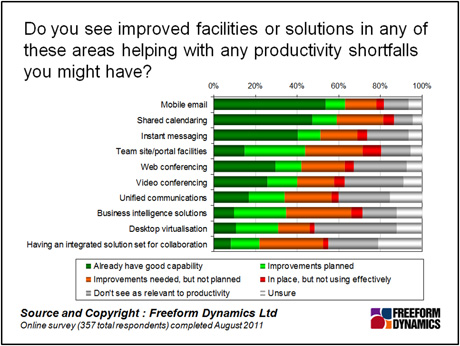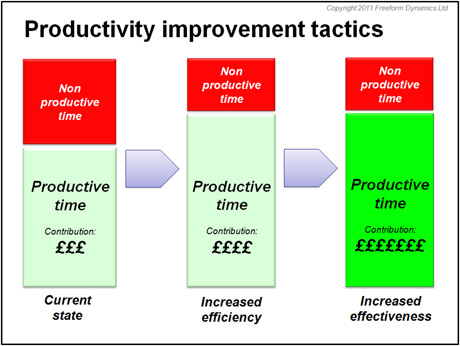The role – and limits – of technology as an enabler of productivity gains
‘Productivity’, and how to improve it, is a discussion topic that simply isn’t going away. Despite what vendor marketing hype may lead us to believe, end user productivity issues are by no means a thing of the past. True, plenty of technology solutions exist to support productivity, even if the claims for their efficacy at times border on the miraculous. So why is it that we’re still struggling with this issue? Is it because the technologies that are available aren’t being deployed? Is it because they’re not used to best effect? Is the plethora of products and services in itself part of the problem? Or is there another key ingredient that’s missing?
Let’s start with a snapshot of how productivity is viewed today, and how well organisations are doing. To find out, we surveyed 357 IT professionals. As can be seen from the responses summarised in the chart below, there is a high degree of consensus regarding the key elements of productivity. It’s equally clear, though, that a recognition of what’s important doesn’t equate to what organisations have actually been able to achieve.

We also asked respondents about their use of technology in the context of productivity; we excluded standard office software such as email, word processing and spread sheets, as these tend to be almost universally available in today’s business environment. The picture that emerged is somewhat mixed.

As shown in the chart, many organisations have good capabilities in a number of these technologies. At the same time, though, a considerable proportion of IT professionals don’t see the relevance to productivity of a number of solutions. Equally striking is the comparatively high proportion of respondents who recognise the need to address productivity shortfalls, but have no plans in place to make improvements. The discrepancy is particularly striking when it comes to business intelligence, in particular when taking into account that “people have the information they need when they need it” is regarded as the most important element of employee productivity (as highlighted in our first chart).
Whether it’s being sceptical or unsure, or not planning improvements despite recognising the need, there’s likely to be a combination of reasons for taking a particular stance, rather than any single specific factor. It’s also clear that we’re looking at a mix of technology and non-technology factors. More importantly, we’re faced with a range of drivers and issues that cuts right across the entire organisation’s processes and technology landscape. It’s this very complexity and far-ranging nature of both the problem and the solution set that leads to either a complete lack of action, or productivity-enhancement projects being undertaken in a piecemeal fashion.
But it’s not just the enormity of a potential business wide ‘productivity improvement project’ that’s preventing most organisations from taking concrete steps to improve workforce productivity. It’s also the fact that productivity shortcomings often aren’t apparent, or are only recognised by those immediately affected.
The impact on productivity of badly integrated systems, convoluted processes, or the introduction of a new system, is hardly ever taken into account, let alone measured. Also, employees typically compensate for system inefficiencies or their own lack of knowledge and expertise by simply working longer hours. There are many other examples one could cite of unrecognised productivity losses, and many of these on their own may be limited in their impact. Taken together, the consequences for the business can be serious.
This is where we get to the root of the matter: any business that’s serious about improving productivity first needs to establish how long a particular process or task should take, and what information is required to complete it; the next step is to examine whether existing processes, applications and tools are fit for purpose. This goes hand in hand with gaining an in-depth understanding of what a particular tool or application does, developing best practice for its use, and providing appropriate training and guidance to ensure that employees can work with it to best effect.
Of course this is easier said than done, and we’re not advocating that anybody tries to embark upon a ‘boil-the-ocean’-type productivity improvement project. What we do advocate is ensuring that productivity is a key element in any review of systems and processes, whether it’s continuous or in the context of a specific project.
Finally, there’s another crucial element to take into account: effectiveness. Not doing so will always limit the extent to which productivity gains will make a difference to the bottom line (as illustrated schematically below). Many process and system optimisation projects focus on efficiency, that is ‘doing things right’. While that is valuable, it is not as important as ‘doing the right things’: it doesn’t matter how quickly and efficiently a task is performed if it isn’t worth doing in the first place.

Going back to the questions posed at the beginning: technology has a key role to play in improving employee productivity; equally, technology can become part of the problem, if it’s badly deployed. Most important, however, is never to look at any technology or solution in isolation, whether or not it’s labelled ‘productivity –enhancing’. And beware of any claims promising otherwise.
CLICK HERE TO VIEW ORIGINAL PUBLISHED ON

Content Contributors: Martha Bennett
Through our research and insights, we help bridge the gap between technology buyers and sellers.



Have You Read This?
Generative AI Checkpoint
From Barcode Scanning to Smart Data Capture
Beyond the Barcode: Smart Data Capture
The Evolving Role of Converged Infrastructure in Modern IT
Evaluating the Potential of Hyper-Converged Storage
Kubernetes as an enterprise multi-cloud enabler
A CX perspective on the Contact Centre
Automation of SAP Master Data Management